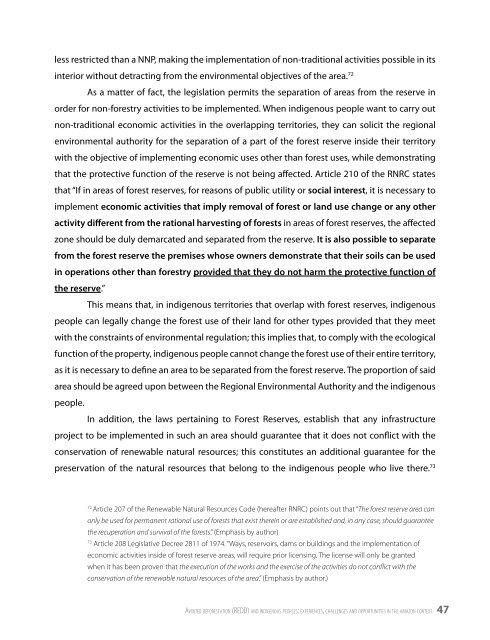Avoided Deforestation (REDD) and Indigenous ... - Amazon Fund
Avoided Deforestation (REDD) and Indigenous ... - Amazon Fund
Avoided Deforestation (REDD) and Indigenous ... - Amazon Fund
Create successful ePaper yourself
Turn your PDF publications into a flip-book with our unique Google optimized e-Paper software.
less restricted than a NNP, making the implementation of non-traditional activities possible in its<br />
interior without detracting from the environmental objectives of the area. 72<br />
As a matter of fact, the legislation permits the separation of areas from the reserve in<br />
order for non-forestry activities to be implemented. When indigenous people want to carry out<br />
non-traditional economic activities in the overlapping territories, they can solicit the regional<br />
environmental authority for the separation of a part of the forest reserve inside their territory<br />
with the objective of implementing economic uses other than forest uses, while demonstrating<br />
that the protective function of the reserve is not being affected. Article 210 of the RNRC states<br />
that “If in areas of forest reserves, for reasons of public utility or social interest, it is necessary to<br />
implement economic activities that imply removal of forest or l<strong>and</strong> use change or any other<br />
activity different from the rational harvesting of forests in areas of forest reserves, the affected<br />
zone should be duly demarcated <strong>and</strong> separated from the reserve. It is also possible to separate<br />
from the forest reserve the premises whose owners demonstrate that their soils can be used<br />
in operations other than forestry provided that they do not harm the protective function of<br />
the reserve.”<br />
This means that, in indigenous territories that overlap with forest reserves, indigenous<br />
people can legally change the forest use of their l<strong>and</strong> for other types provided that they meet<br />
with the constraints of environmental regulation; this implies that, to comply with the ecological<br />
function of the property, indigenous people cannot change the forest use of their entire territory,<br />
as it is necessary to define an area to be separated from the forest reserve. The proportion of said<br />
area should be agreed upon between the Regional Environmental Authority <strong>and</strong> the indigenous<br />
people.<br />
In addition, the laws pertaining to Forest Reserves, establish that any infrastructure<br />
project to be implemented in such an area should guarantee that it does not conflict with the<br />
conservation of renewable natural resources; this constitutes an additional guarantee for the<br />
preservation of the natural resources that belong to the indigenous people who live there. 73<br />
72 Article 207 of the Renewable Natural Resources Code (hereafter RNRC) points out that “The forest reserve area can<br />
only be used for permanent rational use of forests that exist therein or are established <strong>and</strong>, in any case, should guarantee<br />
the recuperation <strong>and</strong> survival of the forests.” (Emphasis by author)<br />
73 Article 208 Legislative Decree 2811 of 1974. “Ways, reservoirs, dams or buildings <strong>and</strong> the implementation of<br />
economic activities inside of forest reserve areas, will require prior licensing. The license will only be granted<br />
when it has been proven that the execution of the works <strong>and</strong> the exercise of the activities do not conflict with the<br />
conservation of the renewable natural resources of the area.” (Emphasis by author.)<br />
Av o i d e d d e f o re s t A t i o n (redd) A n d i n d i g e n o u s p e o p l e s: experiences, chAllenges A n d o p p o r t u n i t i e s in t h e A m A zo n c o n t e x t 47
















